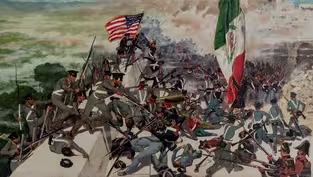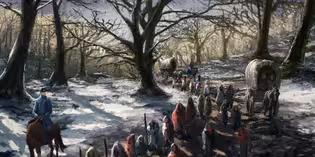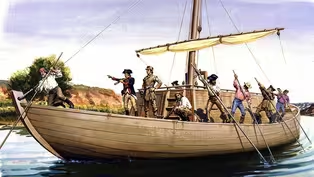
The California Gold Rush
Season 2 Episode 4 | 14m 40sVideo has Closed Captions
Learn how the discovery of gold in California transformed the American west!
January 24, 1848 started out as a typical work day for carpenter James W. Marshall. While digging a channel for a sawmill, he noticed gold nuggets in the water below him. Little did he know that his discovery would cause one of the largest mass movements of human beings in world history, and fast track California to become a state in 1850. Learn how the California Gold Rush transformed the west!
Problems playing video? | Closed Captioning Feedback
Problems playing video? | Closed Captioning Feedback
History in a Nutshell is a local public television program presented by SCETV

The California Gold Rush
Season 2 Episode 4 | 14m 40sVideo has Closed Captions
January 24, 1848 started out as a typical work day for carpenter James W. Marshall. While digging a channel for a sawmill, he noticed gold nuggets in the water below him. Little did he know that his discovery would cause one of the largest mass movements of human beings in world history, and fast track California to become a state in 1850. Learn how the California Gold Rush transformed the west!
Problems playing video? | Closed Captioning Feedback
How to Watch History in a Nutshell
History in a Nutshell is available to stream on pbs.org and the free PBS App, available on iPhone, Apple TV, Android TV, Android smartphones, Amazon Fire TV, Amazon Fire Tablet, Roku, Samsung Smart TV, and Vizio.
Providing Support for PBS.org
Learn Moreabout PBS online sponsorshipMore from This Collection
Video has Closed Captions
Learn how President James K. Polk acquired Mexico's northern territories in the 1840's! (13m 44s)
Video has Closed Captions
Learn about the history of the Indian Removal Act and the Trail of Tears. (12m 41s)
The Lewis and Clark Expedition
Video has Closed Captions
Watch a brief expose on the history of Lewis and Clark's "Corps of Discovery"! (29m 46s)
Providing Support for PBS.org
Learn Moreabout PBS online sponsorship♪♪ ♪Hammering/whistling♪ Andrew: Anyone who has ever gone mining or prospecting can tell you, this is some hard work.
Unfortunately, hard work doesn't always pay off.
Sometimes luck has to be on your side.
This edition of "History in a Nutshell".
We'll explore such a case, the California gold rush.
The discovery of gold in the late 1840s changed the American West forever.
Hundreds of 1000s of folks from the United States And abroad flocked to California with hopes And dreams of making a quick buck mining for gold.
While some did make a considerable profit during the Gold Rush, many others were not quite so lucky.
Making the trek to California was difficult enough.
But many who actually made it to California had to face long periods of grueling backbreaking labor on top of the dog eat dog lawlessness of the Wild West.
The Gold Rush as a significant event in American history, And essentially fast tracked California to becoming a state in 1850.
From 1848 to 1855, about $2 billion worth of precious metal was extracted from the area during the Gold Rush, which reached its peak in 1852.
Join me as we dig a little deeper into the history of the gold rush.
As the Mexican American War concluded, California became an American possession.
At the time, the area was populated by about 6500 Californio's 700 Americans, And 150,000 Native Americans.
January 24 1848, was a typical workday for Carpenter, James W. Marshall.
Marshall was commissioned by German born Swiss pioneer John Augustus Sutter to construct a water powered sawmill in Coloma.
Located on the American River.
Sutter was the founder of the colony called Nueva Helvetia, which is present day Sacramento.
While digging a channel for the sawmill, Marshall looked down And saw shiny metallic flakes in the water below him.
As soon as the workday was over, Marshall made a four day trip to present his discovery to Sutter.
After running some tests, it turned out that the shiny metal flakes Marshall found were indeed pure gold.
Despite Sutter And Marshall wanting to keep the discovery a secret, it would not take long for rumors of a gold discovery to circulate in nearby San Francisco.
In April 1848, some curious San Franciscans made their way to the South Fork of the American River to do some digging for themselves.
One of these curious San Franciscans was a business owner by the name of Sam Brannan.
In May, Brannon returned to San Francisco where he excitedly confirmed the rumors while running up And down the streets like a madman holding a glass bottle filled with gold dust.
To say that San Francisco became a blaze with excitement would be an understatement.
Many San Franciscans dropped whatever they were doing right then in there And made a beeline for Sutter's Fort with hopes of finding gold.
Soon after, news of the gold discovery spread north And south And Californians journeyed to the Sierra Nevada mountains with hopes of striking it rich.
Sam Brannan ended up becoming California's first millionaire.
He made his fortune selling mining supplies to gold seekers.
In just 10 weeks, Brannons store took in around $36,000 worth of gold, about $1 million in today's value.
News of gold And California spread to the East Coast.
However, many were skeptical at first, taking the news as exaggerated.
That would all change on December 8 1848 When President James K Polk officially announced during a congressional address that the news is true.
Gold has indeed been found in California.
Many American citizens soon found themselves gripped with gold fever, and a massive movement westward began.
1000s of Eastern Americans, mostly men, made their way to the Sierra Nevada Mountains, the location of the mother lode.
Although some women did tag along for the journey, most were left behind to run the businesses and farms.
People from other parts of the world, including Europe, China, Mexico, And South America flocked to California as well.
Out of all the foreigners traveling to California, the Chinese, which made their way across the Pacific Ocean, was the largest group.
They came to America to escape the political And economic turmoil of the ruling Ching government And the destruction from the Taiping Rebellion.
Starting over in the US seemed like a breath of fresh air for Chinese immigrants.
All these folks making the journey to California were called Forty-Niners.
Yep, that's how a certain football team in California got its name.
So how did Americans get to California, there were primarily three ways.
The first was by sailing ship to sail all the way around South America, turning at Cape Horn, And then sailing up the Pacific Ocean to San Francisco.
That trip typically took between four to six months.
The second was to take a steamship to the Isthmus of Panama.
Cross overland, then take another steamship up to San Francisco.
The third And most popular way was to cross the North American continent via the Oregon And California trails.
With all these folks heading to California, this made for tremendous business opportunities.
Companies such as the US Mail Steamship Company, And the Pacific mail Steamship Company obtained vast wealth among their owners.
Wells Fargo got its start during the gold rush as an express shipping company And bank, transporting gold bullion, mail, And other valuables back And forth between the east And west coasts of the US.
Mining towns sprung up all over California.
In order to accommodate the mass influx of gold seekers, many businesses such as shops, hotels, saloons, And more were established with a goal of making their own fortunes.
Wagon drivers called teamsters turned a good profit by taking supply goods to California.
The flooding of people to San Francisco caused that town's population to explode.
In 1848, there were roughly only 600 people living there.
Two years later, you're looking at between 25,000 to 30,000 people, with more arriving every single day.
Once folks got to California, how was gold obtained , the goal was to find as much gold as quickly as possible.
Mining technology radically advanced thanks to determination And ingenuity.
The money was in the ground, And the more dirt prospectors could process at a time, the more gold they were likely to find.
The most common method was called placer mining, where miners would come stream beds for gold using various tools.
Prospectors panned for gold by collecting dirt in a pan And used water from a stream to filter out gold from unwanted debris.
Panning worked, but was notoriously slow.
Newer tools such as rockers And long toms were invented to process larger loads of dirt at a faster rate.
Actually, finding gold was more a matter of luck than anything.
Depending on where one mined, some location claims turned a small fortune, while others turned up little to nothing at all.
Most of the surface gold dried up by around 1850 but the demand for profit continued to increase.
Industrialization led to a new mining method And 1853 called hydraulic mining, where prospector has built dams And used high pressure water jets to clear away massive amounts of gold bearing dirt And gravel.
By the end of the 1850s, the California Gold Rush fizzled out.
The most profitable deposits in California became exhausted.
And once that happened, many miners went to look for gold elsewhere.
When the Comstock Lode was discovered in Nevada in 1859, many left California, creating a new rush.
What are the lasting legacies of the California gold rush?
The rush was one of the largest single movements of human beings in world history.
More than 300,000 people from all over the world came to California searching for that precious substance.
While some folks made fortunes during the rush, it came at a cost.
Merchants And entrepreneurs made far more profit than the miners themselves did.
On the plus side, many of the businesses formed during the rush prospered, And America's economy boomed thanks to the sudden influx of gold And capital.
The California Gold Rush was so profitable in fact, economies all over the globe experienced stimulation.
Many miners who didn't strike it lucky finding gold were able to cash in on green gold.
Some folks traded in their mining tools for farming equipment, And took advantage of California's climate to establish prosperous farms.
People certainly needed to eat during the rush.
While the rush had its perks, it unfortunately created massive negative impacts for California as well.
Much of California's landscape was destroyed by the hydraulic mining, And the dams built for hydraulic mining took much needed water away from surrounding farmlands.
Hydraulic mining became so destructive that the practice was eventually banned by federal law in 1884.
Massive amounts of mercury were used to extract gold from the ground.
So much mercury was used during the rush that the waters surrounding the Sierra Nevada Mountains are still contaminated with it, And could possibly remain that way for around 10,000 years.
If someone found gold, those findings could just as easily be taken away.
There was little to no law enforcement And California's Gold fields And crimes like robberies And murder were common.
Many women became widows thanks to crime, mining accidents, or disease.
Additionally, one could work all day mining for gold And then turn around And lose it by drinking or gambling it all away.
Oppression of minorities was another major issue during the rush.
When the supply of gold began to dwindle, violence And anti immigrant tension skyrocketed.
Many Chinese immigrants were hard workers at first welcomed by their mining compatriots.
Unfortunately, they soon became victims of prejudice, accused of stealing the gold which white miners believed belong to them.
California's government even went so far as to impose a $20 per month tax on immigrants in 1850.
The anti-immigrant sentiment became so bad that people from France, Mexico And Chile gave up And went back to their home countries.
The demographic which suffered the worst was California's Native American population.
The sudden rush of people to California brought diseases which Native Americans were not prepared to handle.
The increase in farms pushed many American Indians from their homes, gravel, silt And toxic chemicals for mining operations, destroyed habitats And killed fish.
Around 150,000 American Indians lived in California just before the rush due to genocides, diseases And destruction of habitats.
By 1873, roughly 30,000 remained.
Support for PBS provided by:
History in a Nutshell is a local public television program presented by SCETV


















